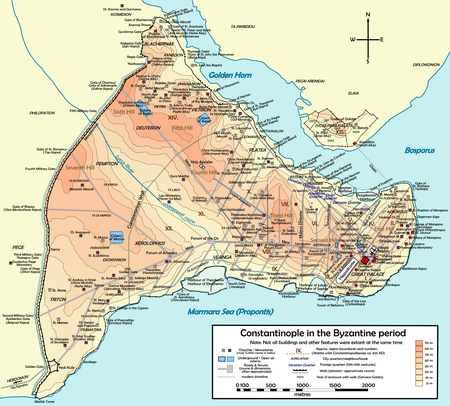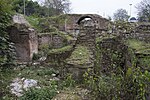Constantinople

Constantinople (; Greek: Κωνσταντινούπολις Kōnstantinoupolis; Latin: Constantinopolis; Ottoman Turkish: قسطنطينيه, romanized: Ḳosṭanṭīnīye) was the capital of the Roman/Byzantine Empire (330–1204 and 1261–1453), the Latin Empire (1204–1261), and the Ottoman Empire (1453–1922). The capital then moved to Ankara following the Turkish War of Independence. Officially renamed Istanbul in 1930, the city is today the largest city and financial centre of the Republic of Turkey (1923–present). It remains the largest city in Europe. In 324, the ancient city of Byzantium was renamed "New Rome" and declared the new capital of the Roman Empire by Emperor Constantine the Great, after whom it was renamed, and dedicated on 11 May 330. Constantinople is generally considered to be the center and the "cradle of Orthodox Christian civilization". From the mid-5th century to the early 13th century, Constantinople was the largest and wealthiest city in Europe. The city became famous for its architectural masterpieces, such as Hagia Sophia, the cathedral of the Eastern Orthodox Church, which served as the seat of the Ecumenical Patriarchate, the sacred Imperial Palace where the Emperors lived, the Galata Tower, the Hippodrome, the Golden Gate of the Land Walls, and opulent aristocratic palaces. The University of Constantinople was founded in the fifth century and contained artistic and literary treasures before it was sacked in 1204 and 1453, including its vast Imperial Library which contained the remnants of the Library of Alexandria and had 100,000 volumes. The city was the home of the Ecumenical Patriarch of Constantinople and guardian of Christendom's holiest relics such as the Crown of thorns and the True Cross. Constantinople was famed for its massive and complex fortifications, which ranked among the most sophisticated defensive architecture of Antiquity. The Theodosian Walls consisted of a double wall lying about 2 kilometres (1.2 mi) to the west of the first wall and a moat with palisades in front. Constantinople's location between the Golden Horn and the Sea of Marmara reduced the land area that needed defensive walls. The city was built intentionally to rival Rome, and it was claimed that several elevations within its walls matched Rome's 'seven hills'. The impenetrable defenses enclosed magnificent palaces, domes, and towers, the result of prosperity Constantinople achieved as the gateway between two continents (Europe and Asia) and two seas (the Mediterranean and the Black Sea). Although besieged on numerous occasions by various armies, the defenses of Constantinople proved impenetrable for nearly nine hundred years. In 1204, however, the armies of the Fourth Crusade took and devastated the city and, for several decades, its inhabitants resided under Latin occupation in a dwindling and depopulated city. In 1261 the Byzantine Emperor Michael VIII Palaiologos liberated the city, and after the restoration under the Palaiologos dynasty, it enjoyed a partial recovery. With the advent of the Ottoman Empire in 1299, the Byzantine Empire began to lose territories and the city began to lose population. By the early 15th century, the Byzantine Empire was reduced to just Constantinople and its environs, along with Morea in Greece, making it an enclave inside the Ottoman Empire; after a 53-day siege the city eventually fell to the Ottomans, led by Sultan Mehmed II, on 29 May 1453, whereafter it replaced Edirne (Adrianople) as the new capital of the Ottoman Empire.
Excerpt from the Wikipedia article Constantinople (License: CC BY-SA 3.0, Authors, Images).Constantinople
15 Temmuz Şehitleri Caddesi, Istanbul
Geographical coordinates (GPS) Address Website Nearby Places Show on map
Geographical coordinates (GPS)
| Latitude | Longitude |
|---|---|
| N 41.013888888889 ° | E 28.955555555556 ° |
Address
Istanbul Büyükşehir Belediyesi
15 Temmuz Şehitleri Caddesi
34134 Istanbul
Türkiye
Open on Google Maps









